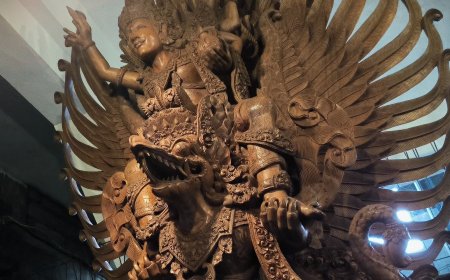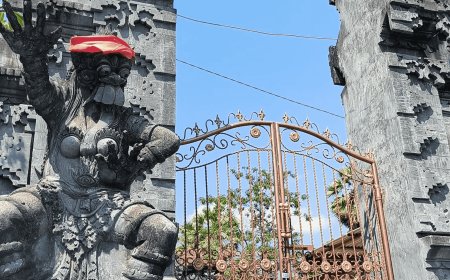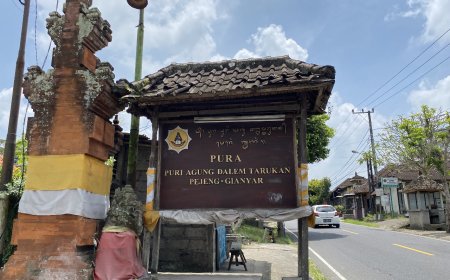Taman Narmada Bali Raja Temple: Trace The Kawitan Maha Gotra Tirta Harum
One of the famous Kawitan temples in Bangli is Taman Narmada Bali Raja Temple. This temple is a unique historical heritage, namely a temple surrounded by gardens and is a legacy of the Tamanbali Kingdom.

Humans in their weakness, always want to find ways to get closer to God. One way that is believed by religious people in this world is to build a holy place. The holy place or sthana for Hindus is called Pura. There are 4 types of temples known to the Balinese people, namely Pura Kahyangan Jagat, Pura Kahyangan Tiga, Pura Swagina, and Pura Kawitan. One of the famous Kawitan temples in Bangli is Taman Narmada Bali Raja Temple. This temple is a unique historical heritage, namely a temple surrounded by gardens and is a legacy of the Tamanbali Kingdom.
Taman Narmada Bali Raja Temple is located in Tamanbali Village, Bangli Regency. This temple can be reached from the city of Denpasar, namely via the main roads of Denpasar, Gianyar and Bangli, which is approximately 33 km or an hour's drive. From the city of Bangli you can reach it by taking the road to the south with a distance of approximately 5 km. The history of the founding of the Taman Narmada Bali Raja Temple is closely related to the Tirta Harum Temple in Tegalwangi Village, Klungkung. This is stated in the Babad Satria Tamanbali.
The origin of this temple is said to be that Sanghyang Subali left his hermitage on Mount Agung, Pedanda Sakti, feeling tired and thirsty because of the long journey. Then the Pedanda went down to the Melangit river to get water to drink. After walking along the river bank, he did not find a spring. He, who was carrying a stick at that time, then stuck his magic stick in a large rock which was right on the river bank. Not long after, a spring of fragrant water emerged from a part of the rock. At the same time as the water came out, a beautiful and beautiful girl named I Dewa Ayu Njung Asti appeared. Finally, the girl was asked to guard the holy spring and the place was called Tirta Harum.
Bhatara Wishnu smelled the fragrant water, so he decided to go down and bathe in the Tirta Harum spring. At that time, Bhatara Wishnu accidentally left his semen in the form of fruit. In short, Dewi Njung Asti ate the fruit and became pregnant and was finally invited to Wishnu Loka by Bhatara Wishnu. One day, Sanghyang Subali asked Bhatara Wishnu to have a child. While waiting for his wish to be granted, he and his brother always looked after the holy spring and made a garden resembling Majalangi and named it Tamanbali.
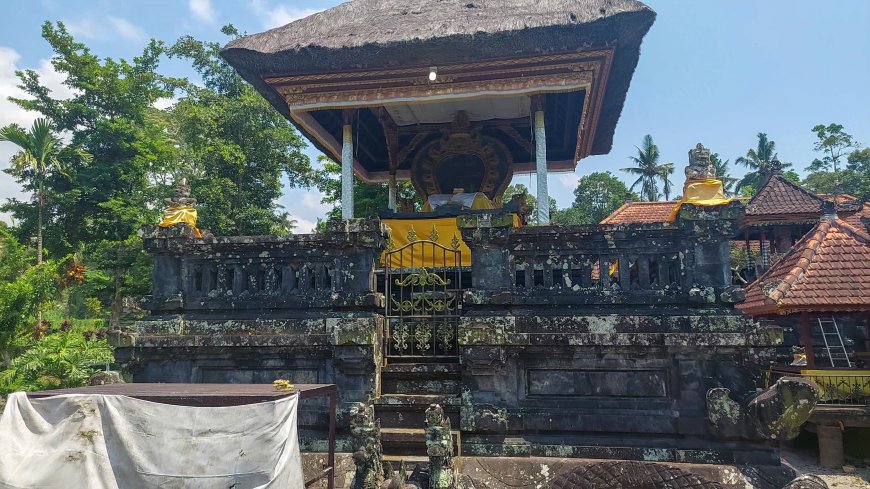
Pelinggih Pulo (Photo Source: Author’s Collection)
Finally, Sanghyang Subali's wish was granted, namely the birth of a son who was a gift from Bhatara Wishnu, from Dewi Njung Asti, and was named Sang Gangga Tirta. Long story short, Sang Angga Tirta or Sang Anom married Dewi Ayu Mas, who is the daughter of Sanghyang Sekar Angsana Dalem. They also lived in Taman Bali and founded a kingdom there . Before moksa, Bhatara Subali gave some advice to Sang Anom, to remind his descendants to always cherish their place of origin, namely Tirta Harum. Apart from that, he also gave the name of Sang Anom's descendants who were known as the Satria Tamanbali or Mahagotra Tirta Harum. Not to forget, he also entrusted the garden he had created to be looked after. Remembering this advice, Sang Anom during his reign established a place of worship, namely the Kawitan Maha Gotra Tirta Harum Temple and also the Taman Narmada Bali Raja Temple.
The concept of spatial division of the Taman Narmada Bali Raja Temple is divided into two, namely Utama Mandala and Madya Mandala. The Madya Mandala or often called Jaba Tengah is the central courtyard of the Taman Narmada Bali Raja Temple. This area is surrounded by ponds and gardens which are quite large and beautiful. The pool is located to the south of the temple area, extending from East to West of Taman Narmada Bali Raja Temple. In the Madya Mandala Area there are complementary buildings, namely Bale Pesantian, Bale Gong and Bale Kulkul. Apart from that, there are also several pelinggih, including Pelinggih Lebuh (a place of worship to Betara Sang Hyang Baruna as the ruler of the sea), Pelinggih Apit Lawang (two twin pelinggih as guardians of the entrance to the Main Mandala area), and Pelinggih Ulun Danu (a place of worship to Ulun Danu or Ida Dewi Danu Temple), as well as Pelinggih Pulo which is located alone in the middle of the temple, precisely in the middle of the pond facing south. Pelinggih Pulo is the stana of Hyang Betara Subali (Kawitan Semeton Maha Gotra Tirta Harum) because he was a priest, he made a solitary pelinggih outside the temple or in the middle of the garden.
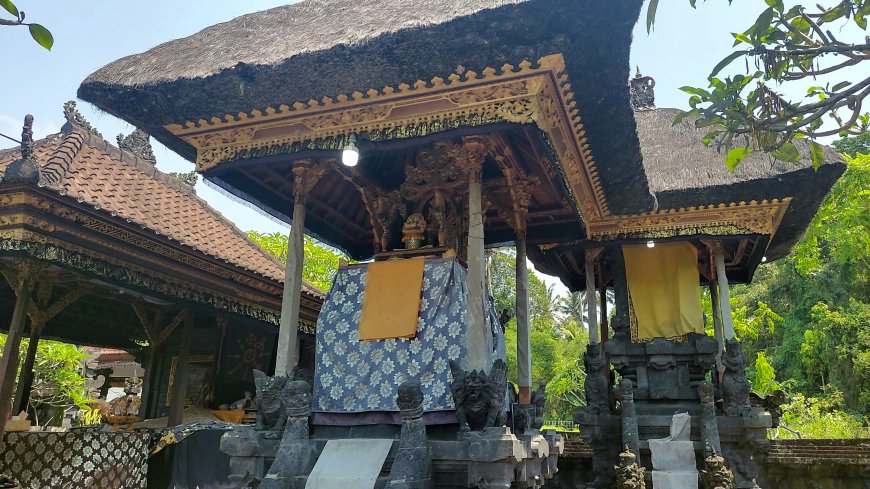
Pelinggih Pengaruman (Photo Source: Author’s Collection)
The Utama Mandala area or Jeroan is the most sacred area of the temple. When entering the inner courtyard of the Taman Narmada Bali Raja Temple, you will be greeted by the temple of briefly which functions as a purification or healing. In the Jeroan Area there are several pelinggih buildings, including: Pelinggih Pengaruman is the main pelinggih which is located in the middle of the main mandala; Pelinggih Pengaruman functions as a witana (meeting place) for the Gods and Goddesses during pujawali; Then, there is Gedong Penyineban which is a place of worship to I Dewa Njung Asti (Pereratu Ratih Megelung); Furthermore, Pelinggih Meru Tumpang Telu is a place of worship for Sang Hyang Aji Rembat (Betara Ratu Dukuh Sakti); Next, Pelinggih Taksu Agung Ida Betara. This pelinggih, which is located to the north, is a place of worship for I Ratu Nyoman Sakti Pengadangan; Then there is the Pelinggih Padmasana which functions to worship Siwa Raditya; Next there is Pelinggih Gedong which is the shrine of Ida Betara Sakti Wawu Rauh; Next, the Pelinggih Pengerurah Agung is located to the East which is a place to ask for the safety of animals; Bale Paselang is the building where Sang Hyang Semara Ratih lives, which is generally used as a place for sulinggih during certain ceremonies; Lastly, Pelinggih Pepanggungan is where the Rerencangan temple is located. So that the temple planners do not interfere with the ceremony. Apart from the pelinggih, there are also complementary buildings in the main area of the mandala, namely Bale Piasan and Bale Pawedan Jero Mangku.
Piodalan at Taman Narmada Bali Raja Temple is held at Saniscara Kliwon Landep. This temple has its own uniqueness, where its location is surrounded by very beautiful gardens and lakes. Pura Taman Narmada Bali Raja is also clear evidence of the historical journey of the formation of the kingdom in Bangli Regency as well as the forerunner of the Bali Taman Knights and Mahagotra Torta Harum. Therefore, the temple must be preserved so that later we can always visit and get to know one of the historical temples in Bangli Regency, Taman Bali Village.






































